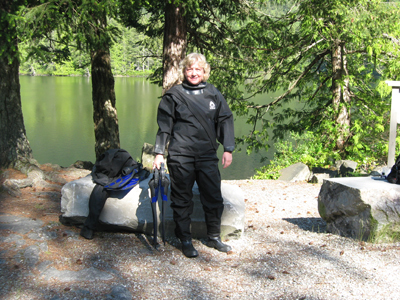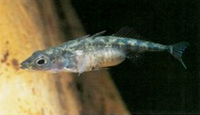Dianne Suggs, Doctoral Student

Research Interests
My general interests lie in the areas of animal communication and sexual selection. Using the adaptive radiation of the threespine stickleback fish, I am exploring the evolution of female mating preferences and asking how these preferences change with age. Another interest involves understanding the strategies/decision rules used by female stickleback in choosing a mate. These are long-term interests of mine; interests I pursued as an undergraduate and between my graduate and undergraduate work.
As an undergraduate, I examined mother-infant interactions among wild mantled howler monkeys (Alouatta palliata), assortative mating in horseshoe crabs (Limulus polyphemus) and vocal communication in male American bullfrogs (Rana catesbeiana). After receiving my undergraduate degree, I participated in cognitive research involving captive tufted capuchins (Cebus apella) and mother-infant communication in free-ranging Rhesus macaques (Macaca mulatta). All of the research in which I engaged made it clear to me that I wished to pursue graduate research in some aspect of communication and sexual selection. I was fortunate to find the stickleback radiation, which enables me to address questions involving the evolution of female mating preferences and strategies in unusual and exciting ways.
Mate preference in female stickleback across ecotypes.
Recent research in the Foster-Baker lab has focused on variation in courtship behavior and nuptial coloration across ecotypes in the male threespine stickleback. In the field, intense coloration and vigorous courtship behavior are typically expressed in the limnetic (plankton-feeding) ecotype, while drab coloration and a less conspicuous form of courtship behavior (dorsal pricking) are commonly found in the benthic (bottom-feeding) ecotype. These differences appear to be driven by trophic behavior and the incidence of cannibalistic groups. Interestingly, when wild-caught males are brought into the lab and allowed to nest, males from both ecotypes adopt bright nuptial coloration and court females with the highly salient zig-zag dance. These observations suggest that conspicuousness of courtship display is a plastic trait in the threespine stickleback male, depending upon environmental factors.
The ability of a male to modify the intensity of his courtship display is commonly found in oceanic stickleback males, and thus is considered to be representative of the ancestral behavior. With this in mind, I am first asking whether females from limnetic and benthic ecotypes maintain sexual receptivity to both styles of courtship, or if they have evolved novel mating preferences that match the characteristics of males that are expressed in the field. So, for example, have females in benthic populations evolved a preference for drab, dorsal pricking males, even though these characteristics are not genetically fixed in the male, but rather are induced by encounters with foraging groups? By using video images of courting males, I am able to decouple nuptial coloration and courtship behavior in an effort to determine which trait(s) females of limnetic and benthic ecotypes prefer.
 Individual variation and repeatability in female mate choice
Individual variation and repeatability in female mate choice
In the past, studies involving sexual selection focused almost exclusively on variation in male ornamentation and courtship behavior, and very little on variation in mating preferences among females. Often female mating preferences were regarded as species-specific, stereotypical traits. Recently, however, researchers have begun to more closely examine how sexual preferences, selectivity (degree of choosiness), and mate sampling tactics differ among conspecific females. Using a longitudinal research design, I plan to track individual preferences in a generational cohort of female stickleback over their reproductive lifetimes. This will provide data on variability between females, as well as repeatability of individual females’ choices.
Particularly of interest to me is the question of the effect of age on female sexual preferences. Although this question had received little theoretical or empirical attention in the past, investigators have begun to examine these issues in a variety of species. Results from a few recent studies suggest that older females may use a different set of criteria when choosing their mates than do younger females. Such differences can have an important stabilizing effect on phenotypic variation in males. I am also interested in exploring the effects of aging on mate selectivity (choosiness) in females. It has long been hypothesized that as a female ages and experiences a decrease in reproductive potential, a decline in mate selectivity should occur as well. Because my longitudinal data include such information as number/weight of eggs per clutch, and number of clutches per year for individual females, I should be able to document changes in reproductive potential across the lifetimes of females.
Female decision rules and mating strategies
A fascinating question regarding sexual selection is: how do females arrive at their mate choice decisions? A number of theoretical mate search models have been proposed to explain such decisions. Among these models are random mate choice, best-of-N (or comparison) tactics, and fixed or adjustable threshold tactics. Models most relevant to the threespine stickleback share several basic assumptions: (1) mobile females visit sedentary males, (2) females search for a single, acceptable male, (3) females encounter potential mates sequentially, rather than simultaneously, and (4) potential mates are encountered randomly with respect to quality. I plan to test these models by following individual gravid females as they conduct their mate choice searches in a semi-natural environment, where environmental and mate quality factors can be controlled.
Education
Brown University, Providence,
Rhode Island Sc.B., Honors, Psychology
Publications:
Semple, S., M.S. Gerald and D.N. Suggs (2009) Bystanders affect the outcome of mother-infant interactions in Rhesus macaques, Proceedings of the Royal Society London B, 276, 2257-2262.
Suggs, D. N. and A. M. Simmons (2005) Information theory analysis of patterns of modulation in the advertisement call of the male bullfrog, Rana catesbeiana, Journal of the Acoustical Society of America, 117, 2330-2337.
Simmons, A. M. and D. N. Suggs (2004) Conveying multiple messages in a single vocalization (lay language paper requested by the press office of the Acoustical Society of America for May 2004 NYC meeting).
Suggs, D. N., R. H. Carmichael, S. P. Grady and I. Valiela (2002) Effects of individual size on pairing in horseshoe crabs, Biological Bulletin, 203, 225-227.